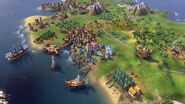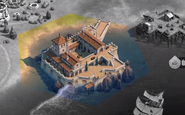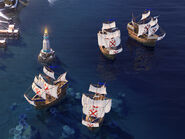The Portuguese people represent a civilization in Civilization VI. They are led by João III, under whom their default colors are white and dark blue. They are available with the Portugal Pack, which was released on March 25, 2021.
The Portuguese civilization ability is Casa da Índia, which restricts the destination of international ![]() Trade Routes to coastal cities and cities with a Harbor, but grants a 50% bonus to their yields. It also gives their Traders increased range over water and the ability to embark as soon as they are unlocked. Their unique unit is the Nau (which replaces the Caravel), and their unique building is the Navigation School (which replaces the University).
Trade Routes to coastal cities and cities with a Harbor, but grants a 50% bonus to their yields. It also gives their Traders increased range over water and the ability to embark as soon as they are unlocked. Their unique unit is the Nau (which replaces the Caravel), and their unique building is the Navigation School (which replaces the University).
Strategy[]
Starting bias: Tier 1 towards Coast
Portugal makes its long-awaited comeback in Civilization VI with the same concept as its previous iterations: a global empire that emphasizes on maritime trade and naval exploration. Under the leadership of João III, the Portuguese fleet can establish a dense trade network to bring back riches from distant shores and then leverage that economic capital for any type of victory.
Note: The following guide will minimize discussions regarding Portugal on a land-dominated map where coastlines either don't exist or bear little importance, most notably Pangaea and Highlands, and, to a lesser extent, Lakes. Maritime civilizations are naturally at a disadvantage on such maps, but Portugal is especially crippled due to the asymmetric design of their civilization ability. For that reason, any of the following strategies will assume:
- The current map setup allows sufficient coastline access to the majority of the civilizations in the game.
- Avoiding settling on the coast or building Harbors specifically to counter Portugal cannot be attempted without significant repercussions.
Casa da Índia[]
Restrictions[]
There are more caveats and restrictions to this ability than meets the eye. Let's first go over the restrictions that apply to all civilizations in the game when they want to send sea ![]() Trade Routes (sea
Trade Routes (sea ![]() Trade Routes can be defined as ones where the Traders have to embark and disembark at least once during its journey).
Trade Routes can be defined as ones where the Traders have to embark and disembark at least once during its journey).
Both cities (origin and destination) have to have maritime access (either a coastal City Center or a Harbor). Canals work as well, since Canals function as water tiles and they lead straight to the City Center. These maritime access points provide a location that allows Traders to embark or disembark at. However, this alone does not guarantee the establishment of a ![]() Trade Route, it also depends on the locations of these access points. Consider the two situations below:
Trade Route, it also depends on the locations of these access points. Consider the two situations below:
- An inland city with a Harbor in an isolated Lake where it cannot be reached on water. While technically the city has maritime access, that Harbor is as good as dead. There is no way a Trader can reach a Harbor to disembark, and there is nowhere else to go if a Trader embarks at that Harbor, so that Harbor doesn't serve any purpose regarding trading. However, this can be fixed by putting a Canal connecting the Lake Harbor to the open sea, but of course, it depends on the map and cannot always be done.
- You are playing on an Earth map and want to send a sea
 Trade Route to a city situated in Central America. Both that city and its Harbor locate on the left side but your
Trade Route to a city situated in Central America. Both that city and its Harbor locate on the left side but your  Trade Route can only hit the right side of the continent. Again, available maritime access, but cannot be reached, unless there is a Canal connecting the City Center on the left to the open sea on the right.
Trade Route can only hit the right side of the continent. Again, available maritime access, but cannot be reached, unless there is a Canal connecting the City Center on the left to the open sea on the right.
Also, a Trader cannot embark and disembark at the same tile twice on its journey. Let's say, a Trader visits a City Center with an established ![]() Trading Post to refuel. This city is inland but has a "reachable" Harbor. After disembarking at this Harbor and refueling at the City Center, the Trader cannot embark at the same Harbor to continue its journey on water. In fact, it has to travel on land for a while until it finds another maritime access point. This restriction is most pronounced to inland cities with a Harbor or coastal cities with only one Coast tile in the first ring (since it will force the Trader to embark and disembark on that exact tile, which is forbidden, more information provided in photo 1).
Trading Post to refuel. This city is inland but has a "reachable" Harbor. After disembarking at this Harbor and refueling at the City Center, the Trader cannot embark at the same Harbor to continue its journey on water. In fact, it has to travel on land for a while until it finds another maritime access point. This restriction is most pronounced to inland cities with a Harbor or coastal cities with only one Coast tile in the first ring (since it will force the Trader to embark and disembark on that exact tile, which is forbidden, more information provided in photo 1).
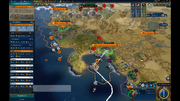
1: Any other civilizations would be able to send a  Trade Route to London through Newcastle, earning more
Trade Route to London through Newcastle, earning more  Gold, but Portugal cannot because of their restrictions (read below) and the fact that the Trader cannot embark again on the Newcastle Harbor where it just disembarked.
Gold, but Portugal cannot because of their restrictions (read below) and the fact that the Trader cannot embark again on the Newcastle Harbor where it just disembarked.
The sea ![]() Trade Route mechanic above applies to all civilizations, including Portugal. However, their civilization ability restricts where you can send your
Trade Route mechanic above applies to all civilizations, including Portugal. However, their civilization ability restricts where you can send your ![]() Trade Routes even further, sometimes without explicitly stating so in the ability description:
Trade Routes even further, sometimes without explicitly stating so in the ability description:
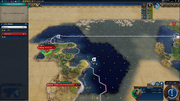
2: The Māori  Capital is clearly within range, but cannot be reached. Please note that Te Hokianga-nui-a-kupe, or any city of any other civilizations at that location, can still send a
Capital is clearly within range, but cannot be reached. Please note that Te Hokianga-nui-a-kupe, or any city of any other civilizations at that location, can still send a  Trade Route to Portugal.[1]
Trade Route to Portugal.[1]
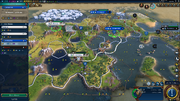
3: Normally Guarda would be able to reach Stirling by going through Aberdeen, but the Portuguese civilization ability prevents it.
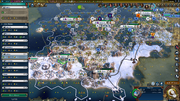
4: Beja cannot send any international  Trade Route by using a nearby Portuguese city as an intermediate. This shouldn't be a problem for any other civilizations.
Trade Route by using a nearby Portuguese city as an intermediate. This shouldn't be a problem for any other civilizations.
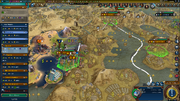
5: Quite a niche situation, but the Incan Qhapaq Ñan helps circumvent the restriction.
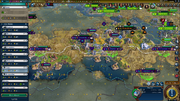
6: Domestic  Trade Routes do not have any more restrictions than normal.
Trade Routes do not have any more restrictions than normal.
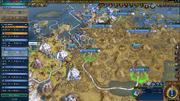
7: Tuttul can be reached through Rapiqum (inland, Harbor 2nd ring) and the Panama Canal. It is worth noting that Tuttul is a city by a Lake (not Coast) without a Harbor.
- First and foremost, Portugal can only send sea international
 Trade Routes. Imagine you spawn on the west coastline of a continent while an opponent has cities on the east coast, unless the continent is small enough that sea
Trade Routes. Imagine you spawn on the west coastline of a continent while an opponent has cities on the east coast, unless the continent is small enough that sea  Trade Routes can reach around, you cannot send cross-continent land
Trade Routes can reach around, you cannot send cross-continent land  Trade Routes to their cities, even if these cities are on the coast or have a Harbor. This is not mentioned anywhere in the ability description.
Trade Routes to their cities, even if these cities are on the coast or have a Harbor. This is not mentioned anywhere in the ability description. - When sending international
 Trade Routes, Portuguese Traders cannot traverse more than 1 land tile before it either embarks or reaches a City Center. This means that cities with their Harbors in the third ring cannot be the target of a Portuguese
Trade Routes, Portuguese Traders cannot traverse more than 1 land tile before it either embarks or reaches a City Center. This means that cities with their Harbors in the third ring cannot be the target of a Portuguese  Trade Route. It is unknown whether this is a bug or intentional (photo 2). This also means that Portuguese cities whose Harbors are in the third ring cannot send international
Trade Route. It is unknown whether this is a bug or intentional (photo 2). This also means that Portuguese cities whose Harbors are in the third ring cannot send international  Trade Route, unless there is another maritime access point (like a Canal) is provided (photo 7 shows an example of using Canals to facilitate trade).
Trade Route, unless there is another maritime access point (like a Canal) is provided (photo 7 shows an example of using Canals to facilitate trade).
- Due to this reason, any two cities can never be connected by land during the journey of the Trader, as long as the final destination is foreign (photo 3 and 4). When sending international
 Trade Routes, any two immediate intermediate cities have to be connected by sea.
Trade Routes, any two immediate intermediate cities have to be connected by sea.
- Due to this reason, any two cities can never be connected by land during the journey of the Trader, as long as the final destination is foreign (photo 3 and 4). When sending international
- Mountains are a base terrain that counts as neither land nor sea, so Mountain Tunnels and Qhapaq Ñan can provide some unique situations where Portuguese
 Trade Routes can reach where they are not normally supposed to (photo 5).
Trade Routes can reach where they are not normally supposed to (photo 5). - Note that all of these restrictions only apply to international
 Trade Routes. When the final destination is internal, the Trader will have no problem connecting any 2 cities, foreign or not, by land (photo 6).
Trade Routes. When the final destination is internal, the Trader will have no problem connecting any 2 cities, foreign or not, by land (photo 6). - A city without maritime access (inland, no Harbor or connecting Canal) can never send international
 Trade Routes. Strangely enough, such a city can use foreign cities as intermediates for its
Trade Routes. Strangely enough, such a city can use foreign cities as intermediates for its  Trade Routes to reach a domestic destination, but can never end its
Trade Routes to reach a domestic destination, but can never end its  Trade Routes outside the empire. Even if this inland Portuguese city is right next to a Portuguese city with maritime access, the city with maritime access cannot be used as intermediate for an international
Trade Routes outside the empire. Even if this inland Portuguese city is right next to a Portuguese city with maritime access, the city with maritime access cannot be used as intermediate for an international  Trade Route sent from the inland city (as per the rule stated above and clarified in photo 4).
Trade Route sent from the inland city (as per the rule stated above and clarified in photo 4). - In very rare cases, foreign cities next to Lakes can still be chosen as the destinations for Portuguese
 Trade Routes, if they are connected to the open sea correctly with Canals. Remember, Canals count as water tiles, so as long as there is passage connecting the Lake the cities are on with the open sea, these cities will be counted as coastal cities, thus can be traded with even when they don't have Harbors (photo 7).
Trade Routes, if they are connected to the open sea correctly with Canals. Remember, Canals count as water tiles, so as long as there is passage connecting the Lake the cities are on with the open sea, these cities will be counted as coastal cities, thus can be traded with even when they don't have Harbors (photo 7).
Boosted yields for international  Trade Routes[]
Trade Routes[]
Note: The data listed below assume you own the Gathering Storm expansion. If you do not, certain Wonders and policy cards may not apply or apply slightly differently to your game experience.
The total yields of an international ![]() Trade Route are calculated based on the types of
Trade Route are calculated based on the types of ![]() Districts present in the destination city, and then modified by other miscellaneous factors. Note that the Portuguese civilization ability grants 50% bonus to all yields (not just
Districts present in the destination city, and then modified by other miscellaneous factors. Note that the Portuguese civilization ability grants 50% bonus to all yields (not just ![]() Gold) after all modifiers have been accounted for, which means the more
Gold) after all modifiers have been accounted for, which means the more ![]() Trade Route modifiers you can stack on top of one another, the more powerful this ability will be. Also, unlike other statistics like adjacency bonus,
Trade Route modifiers you can stack on top of one another, the more powerful this ability will be. Also, unlike other statistics like adjacency bonus, ![]() Trade Route yields do not get rounded down, so you will benefit from every little bit of 0.5 yields, which can be helpful in the early game.
Trade Route yields do not get rounded down, so you will benefit from every little bit of 0.5 yields, which can be helpful in the early game.
(Any yield modifier listed below is before the 50% bonus is accounted for.)
| District | Yields provided as an international destination |
|---|---|
| 3 | |
| 1 | |
| 1 | |
| 1 | |
| 3 | |
| 1 | |
| 1 | |
| 1 | |
| 3 | |
| 1 | |
| 2 | |
| 1 |
Other miscellaneous international ![]() Trade Route yield modifiers are (the list below only counts ones that can be used by Portugal):
Trade Route yield modifiers are (the list below only counts ones that can be used by Portugal):
- Each
 Trading Post established previously by your civilization adds 1
Trading Post established previously by your civilization adds 1  Gold.
Gold. - All
 Trade Routes passing through water tiles gain bonus
Trade Routes passing through water tiles gain bonus  Gold. Also, routes passing through advanced engineering features (such as a Railroad, Canal or Mountain Tunnel) gain additional
Gold. Also, routes passing through advanced engineering features (such as a Railroad, Canal or Mountain Tunnel) gain additional  Gold bonuses. It is calculated as follows:
Gold bonuses. It is calculated as follows:
- Water tiles (Lake, Coast or Ocean), Canal tiles, and Railroad tiles grant 2 "efficiency" points when a Trader passes through.
- Mountain Tunnel tiles or Qhapaq Ñan tiles grant 15 "efficiency" points when a Trader passes through.
- The exact bonus depends on the ratio of "efficiency" points versus the distance traversed by the Trader from the origin to the destination. For example, a
 Trade Route that earns 8 efficiency points on a 16-tile distance will earn 50% bonus toward its base
Trade Route that earns 8 efficiency points on a 16-tile distance will earn 50% bonus toward its base  Gold yield. This bonus caps at 100%.
Gold yield. This bonus caps at 100%. - This percentage-based bonus only applies to basic
 Gold yields from
Gold yields from  Trade Route a.k.a. the
Trade Route a.k.a. the  Gold yield based on the
Gold yield based on the  District present at the destination, it will not enhance unique
District present at the destination, it will not enhance unique  Trade Route bonuses, bonuses from policy cards or the extra
Trade Route bonuses, bonuses from policy cards or the extra  Gold from the Reform the Coinage Dedication.
Gold from the Reform the Coinage Dedication.
- Reyna grants +3
 Gold to every international
Gold to every international  Trade Routes that end or pass through the city she is in.
Trade Routes that end or pass through the city she is in. - Each Feitoria adds 4
 Gold and 1
Gold and 1  Production to Portuguese
Production to Portuguese  Trade Routes that end in the Feitoria's parent city.
Trade Routes that end in the Feitoria's parent city. - The University of Sankore grants +1
 Gold and +1
Gold and +1  Science to all international
Science to all international  Trade Routes that end in its parent city (so this Wonder needs to be built by someone else for Portugal to leverage its bonus).
Trade Routes that end in its parent city (so this Wonder needs to be built by someone else for Portugal to leverage its bonus). - The Torre de Belém adds 2
 Gold to all
Gold to all  Trade Routes from this city for every luxury resource at the destination.
Trade Routes from this city for every luxury resource at the destination. - If sent to a city owned by Cleopatra, the
 Trade Routes receive +2
Trade Routes receive +2  Food.
Food. - The Great Zimbabwe grants 2
 Gold to every
Gold to every  Trade Route starting from its parent city per bonus resource in the city.
Trade Route starting from its parent city per bonus resource in the city. - The follower belief Religious Community grants international
 Trade Routes 2
Trade Routes 2  Gold for every Holy Site and Holy Site building in the origin city.
Gold for every Holy Site and Holy Site building in the origin city. - The Democracy government grants +4
 Food and +4
Food and +4  Production to
Production to  Trade Route when they are sent to cities of an Ally or a vassal city-state.
Trade Route when they are sent to cities of an Ally or a vassal city-state. - The Reform the Coinage Dedication adds 3 more
 Gold for every specialty
Gold for every specialty  District present in the destination city.
District present in the destination city. - With the Suzerainty of Kumasi, each
 Trade Route sent to city-state gets +2
Trade Route sent to city-state gets +2  Culture and +1
Culture and +1  Gold per specialty district in the origin city.
Gold per specialty district in the origin city.
There are a few policy cards that boost the yields of international ![]() Trade Routes even further:
Trade Routes even further:
- Caravansaries: +2
 Gold.
Gold. - Triangular Trade: +4
 Gold, +1
Gold, +1  Faith.
Faith. - Ecommerce: +2
 Production and +5
Production and +5  Gold
Gold - Trade Confederation: +1
 Culture and +1
Culture and +1  Science.
Science. - Market Economy: +1
 Gold per Luxury and Strategic resource improved at the destination, and an additional +2
Gold per Luxury and Strategic resource improved at the destination, and an additional +2  Culture and +2
Culture and +2  Science.
Science. - Wisselbanken: +2
 Food and +2
Food and +2  Production when sent to Allies.
Production when sent to Allies. - Raj: +2
 Gold when sent to city-states.
Gold when sent to city-states.
Better  Trade Routes on water[]
Trade Routes on water[]
A ![]() Trade Route is only considered to be a sea
Trade Route is only considered to be a sea ![]() Trade Route only if the Trader switches mode of transport from sea to land or vice versa at least once at a point of maritime access (Canals, Harbors and City Centers). However, when it comes to international
Trade Route only if the Trader switches mode of transport from sea to land or vice versa at least once at a point of maritime access (Canals, Harbors and City Centers). However, when it comes to international ![]() Trade Routes, there are many restrictions coming into play, so remember to check out the first section. You can send sea
Trade Routes, there are many restrictions coming into play, so remember to check out the first section. You can send sea ![]() Trade Routes from an inland city without a Harbor if you can connect the City Center with the coastline with a Canal or the Panama Canal, and since the game automatically picks the route that generates the most
Trade Routes from an inland city without a Harbor if you can connect the City Center with the coastline with a Canal or the Panama Canal, and since the game automatically picks the route that generates the most ![]() Gold from point A to point B whenever a
Gold from point A to point B whenever a ![]() Trade Route is sent, these
Trade Route is sent, these ![]() Trade Routes can also qualify as sea-based to receive the extra range, but this situation is rare, and thus will not happen in most of your cities. A regular sea
Trade Routes can also qualify as sea-based to receive the extra range, but this situation is rare, and thus will not happen in most of your cities. A regular sea ![]() Trade Route can reach 30 tiles away, a Portuguese one can reach 45 tiles.
Trade Route can reach 30 tiles away, a Portuguese one can reach 45 tiles.
Since Portuguese Traders can embark from the beginning of the game instead of after researching Celestial Navigation, it smooths out the process a lot, but does not cover everything to guarantee your ![]() Trade Routes to be established. One important caveat of sending
Trade Routes to be established. One important caveat of sending ![]() Trade Routes over water is that Traders can only switch from land to sea or vice versa at City Centers, Harbors and Canals (so-called "maritime access"), and both the origin and the destination need to have this maritime access before the Trader can go through. Since the Portuguese civilization ability restricts the destination of your international
Trade Routes over water is that Traders can only switch from land to sea or vice versa at City Centers, Harbors and Canals (so-called "maritime access"), and both the origin and the destination need to have this maritime access before the Trader can go through. Since the Portuguese civilization ability restricts the destination of your international ![]() Trade Routes to coastal cities and ones with Harbors, it (for the most parts) guarantees the first part, but not the second half (again, check out the Restrictions). If for any reason, one of your cities is inland instead of being on the coastline, it would require a Harbor before any Trader sent from there can traverse over water. The Harbor is also unlocked at Celestial Navigation, so it is your call if you want to forgo this aspect of the bonus in favor of more bountiful inland city spots. Also, you still require Cartography before your Traders can enter Ocean tiles, so you won't be able to fully take advantage of your long-ranged sea
Trade Routes to coastal cities and ones with Harbors, it (for the most parts) guarantees the first part, but not the second half (again, check out the Restrictions). If for any reason, one of your cities is inland instead of being on the coastline, it would require a Harbor before any Trader sent from there can traverse over water. The Harbor is also unlocked at Celestial Navigation, so it is your call if you want to forgo this aspect of the bonus in favor of more bountiful inland city spots. Also, you still require Cartography before your Traders can enter Ocean tiles, so you won't be able to fully take advantage of your long-ranged sea ![]() Trade Routes from the get-go.
Trade Routes from the get-go.
Porta do Cerco[]
Extra  Sight for all units[]
Sight for all units[]
This is an incredible ability that goes under the radar for most players, especially new ones. ![]() Sight is a generally underappreciated statistic, since it involves a lot of complex and esoteric behind-the-scene mechanics which are never really explained in the game; therefore, while Gran Colombian civilization ability (+1
Sight is a generally underappreciated statistic, since it involves a lot of complex and esoteric behind-the-scene mechanics which are never really explained in the game; therefore, while Gran Colombian civilization ability (+1 ![]() Movement to all units) instantly pops out as one of those really impactful bonuses, this one does not strike the same.
Movement to all units) instantly pops out as one of those really impactful bonuses, this one does not strike the same.
In the early game, most units, including naval units, have a ![]() Sight of 2. That means, if the terrains are "favorable," your units can see the tiles up to the second ring around them. Since the
Sight of 2. That means, if the terrains are "favorable," your units can see the tiles up to the second ring around them. Since the ![]() Sight statistic indicates a radius of visibility around your units, increasing
Sight statistic indicates a radius of visibility around your units, increasing ![]() Sight by 1 means they can now see 1 tile further in all directions, and that is a crucial puzzle piece but often missing when the power of this ability is considered. This effect is incredibly pronounced at sea, since there is no feature and elevation that can block your vision; all of your naval units effectively can see 18 tiles more every turn than other civilizations, which allows Portugal to be the undisputed king of exploration at any stage of the game.
Sight by 1 means they can now see 1 tile further in all directions, and that is a crucial puzzle piece but often missing when the power of this ability is considered. This effect is incredibly pronounced at sea, since there is no feature and elevation that can block your vision; all of your naval units effectively can see 18 tiles more every turn than other civilizations, which allows Portugal to be the undisputed king of exploration at any stage of the game.
Since Portugal is most likely played on a naval map, Scouts are generally a waste of time, especially on an Island Plates or Archipelago map. You don't want to waste ![]() Production on something that you can only use for a couple turns, and then put on Alert or Fortify for an extended period of time. Portugal has a tier 1 starting bias towards the Coast, as you would expect, so use your Warrior to explore in the direction opposite of the coastline. By settling a city on the coast, you will trigger the
Production on something that you can only use for a couple turns, and then put on Alert or Fortify for an extended period of time. Portugal has a tier 1 starting bias towards the Coast, as you would expect, so use your Warrior to explore in the direction opposite of the coastline. By settling a city on the coast, you will trigger the ![]() Eureka for Sailing, which unlocks Galleys, your first naval unit and your chief exploring vessel. Build at least 2 Galleys to trigger the
Eureka for Sailing, which unlocks Galleys, your first naval unit and your chief exploring vessel. Build at least 2 Galleys to trigger the ![]() Eureka for Shipbuilding and use them to explore in opposite directions until you are the first one to circumnavigate the world and meet all civilizations (more on this later). Also, remember to slot in Diplomatic League when doing this, if Māori is not in the game, it can help you establish a diplomatic foothold with city-states, since you would want to aim for a Diplomatic Victory anyway. Although most of Portuguese uniques are unlocked in Medieval and Renaissance Era, their unmatched prowess in naval exploration can easily earn them a Golden Classical Era. Note that since the Reform the Coinage Dedication (the best Dedication for Portugal) is only available starting in Renaissance Era, try to avoid a Golden Medieval Era as much as possible, maybe aim for a Dark Medieval if you can.
Eureka for Shipbuilding and use them to explore in opposite directions until you are the first one to circumnavigate the world and meet all civilizations (more on this later). Also, remember to slot in Diplomatic League when doing this, if Māori is not in the game, it can help you establish a diplomatic foothold with city-states, since you would want to aim for a Diplomatic Victory anyway. Although most of Portuguese uniques are unlocked in Medieval and Renaissance Era, their unmatched prowess in naval exploration can easily earn them a Golden Classical Era. Note that since the Reform the Coinage Dedication (the best Dedication for Portugal) is only available starting in Renaissance Era, try to avoid a Golden Medieval Era as much as possible, maybe aim for a Dark Medieval if you can.
Portuguese Settlers, thanks to this ability, will have a massive ![]() Sight of 4; however, refrain from using the initial Settler to scout the surroundings. This superior vision allows Portuguese Settlers to spot out danger, like Barbarians, before they are seen, thus giving them a chance to react to imminent threats. Therefore, it is not too dangerous to send out your Settlers unescorted, especially when you know there are not any neighbor civilization around.
Sight of 4; however, refrain from using the initial Settler to scout the surroundings. This superior vision allows Portuguese Settlers to spot out danger, like Barbarians, before they are seen, thus giving them a chance to react to imminent threats. Therefore, it is not too dangerous to send out your Settlers unescorted, especially when you know there are not any neighbor civilization around.
Leif Erikson is a powerful ![]() Great Admiral for Portugal, since he enhances the
Great Admiral for Portugal, since he enhances the ![]() Sight or Portuguese units even further. Since each extra level of
Sight or Portuguese units even further. Since each extra level of ![]() Sight allows you to see an extra ring of tile, the higher the initial
Sight allows you to see an extra ring of tile, the higher the initial ![]() Sight level is, the more powerful an extra
Sight level is, the more powerful an extra ![]() Sight level becomes. Normally, terrains permitting, units with a base
Sight level becomes. Normally, terrains permitting, units with a base ![]() Sight of 2 will see 18 more tiles, units with a base
Sight of 2 will see 18 more tiles, units with a base ![]() Sight of 3 see 24 more tiles. Since under João III, a Portuguese unit will at least have a
Sight of 3 see 24 more tiles. Since under João III, a Portuguese unit will at least have a ![]() Sight of 3, Leif Erickson will let each Portuguese units see at least 24 to 30 more tiles, depending on their initial
Sight of 3, Leif Erickson will let each Portuguese units see at least 24 to 30 more tiles, depending on their initial ![]() Sight level. Also, this
Sight level. Also, this ![]() Great Admiral allows units, including Traders, to cross Ocean tiles without Cartography.
Great Admiral allows units, including Traders, to cross Ocean tiles without Cartography.
Extra  Trade Route capacity when meeting a civilization[]
Trade Route capacity when meeting a civilization[]
If the previous aspect gives you an unparalleled ability to explore, this aspect gives you the incentives to do so. For every new civilization you meet, you gain one additional ![]() Trade Route capacity. There cannot be enough emphasis on how strong this is, the larger the map, the more impactful it will be. Bonuses tied to objectives you would want to do anyway (like Ethiopia's extra
Trade Route capacity. There cannot be enough emphasis on how strong this is, the larger the map, the more impactful it will be. Bonuses tied to objectives you would want to do anyway (like Ethiopia's extra ![]() Faith for improved resources and
Faith for improved resources and ![]() Trade Routes) can be deemed as boring, but very much reliable. With the additional
Trade Routes) can be deemed as boring, but very much reliable. With the additional ![]() Trade Route range over water, Portugal can lay a sound economic foundation very early on, and by trading with other civilizations, you make them like you a little bit more, thus makes it easier to enter an Alliance later for Open Borders.
Trade Route range over water, Portugal can lay a sound economic foundation very early on, and by trading with other civilizations, you make them like you a little bit more, thus makes it easier to enter an Alliance later for Open Borders.
Remember that although your Traders can embark right at the beginning of the game, they still require Cartography in order to cross deep Ocean tiles, so beelining right after Shipbuilding may be the right choice. You only need Buttress after Shipbuilding to reach Cartography, and you will unlock your unique unit very early by doing this, hence extending its limited relevancy.
Open Borders with all city-states[]
This is the least consequential among the 3 aspects of this ability. Permanent Open Borders with city-states mean two things with Portugal. First and most importantly, your exploration will not be obstructed by city-states' borders. No longer will you fear being blocked in a narrow waterway by city-states' territories. Second and slightly less impactful, you can send your Naus to construct Feitorias inside city-states, as long as you are not at war with them. This is not something you always want to do as Portugal, since unless you are trying to a quest of sending ![]() Trade Routes to certain city-states or the Suzerain of Kumasi, you rarely want to send
Trade Routes to certain city-states or the Suzerain of Kumasi, you rarely want to send ![]() Trade Routes there. City-states are a lot more underdeveloped than major civilizations, thus
Trade Routes there. City-states are a lot more underdeveloped than major civilizations, thus ![]() Trade Routes there will not benefit as much.
Trade Routes there will not benefit as much.
Nau[]
The Nau is a decent upgrade to the Caravel, since it adds extra flavors to a unit that is otherwise utterly underwhelming and underused (read more here).
The Nau has no stronger combat statistics when compared to the standard Caravel, which is a step in the right direction, since extra ![]() Combat Strength will easily go to waste on a unit that is not meant for fighting. Instead, each Nau has 2
Combat Strength will easily go to waste on a unit that is not meant for fighting. Instead, each Nau has 2 ![]() build charges to construct Feitorias in foreign cities, special shipping ports that boost
build charges to construct Feitorias in foreign cities, special shipping ports that boost ![]() Gold and
Gold and ![]() Production for every Portuguese
Production for every Portuguese ![]() Trade Route that ends in those cities. Since the main strength of this unit is the Feitoria, your main goal as Portugal is to crank out as many Naus as possible to scout out potential positions for Feitorias. The Nau's low maintenance cost and the Navigation School make the goal a lot easier to achieve. The Venetian Arsenal can be thrown into the mix to amplify this power spike even more, although it is not always compulsory, since the Feitoria has a restrictive placement rule, so having a lot of Naus without suitable places for Feitorias is useless.
Trade Route that ends in those cities. Since the main strength of this unit is the Feitoria, your main goal as Portugal is to crank out as many Naus as possible to scout out potential positions for Feitorias. The Nau's low maintenance cost and the Navigation School make the goal a lot easier to achieve. The Venetian Arsenal can be thrown into the mix to amplify this power spike even more, although it is not always compulsory, since the Feitoria has a restrictive placement rule, so having a lot of Naus without suitable places for Feitorias is useless.
The Nau, just like the unit it replaces, has a very short period of relevance, since its upgrade, the Ironclad, is unlocked with Steam Power, only one era later. You can make it last a little bit longer by 2 methods, each has its own downside:
- Delay researching Steam Power for as long as possible. However, Steam Power leads to Electricity, which unlocks Seaport, a powerful Harbor building for any naval civilization.
- Research Steam Power and Electricity like normal, but deplete your
 Coal stockpile. Without
Coal stockpile. Without  Coal, you can build Naus like normal even though Ironclads are unlocked. However, the absence of
Coal, you can build Naus like normal even though Ironclads are unlocked. However, the absence of  Coal compromises the
Coal compromises the  Production output in your cities.
Production output in your cities.
After expending both ![]() build charges, the Nau basically reverts back to being a Caravel, which is not very useful and will drain your treasury away. Even when Portugal is guaranteed a generous
build charges, the Nau basically reverts back to being a Caravel, which is not very useful and will drain your treasury away. Even when Portugal is guaranteed a generous ![]() Gold income, there is just not much reason to keep these units around when they have clearly outlived their usefulness. You can delete them, and maybe keep some Helmsman-
Gold income, there is just not much reason to keep these units around when they have clearly outlived their usefulness. You can delete them, and maybe keep some Helmsman-![]() Promoted Naus around for exploration. (And yes, Naus start with a free
Promoted Naus around for exploration. (And yes, Naus start with a free ![]() Promotion, even ones upgraded from Galleys, but considering how often they will be used for any reason other than exploring and Feitoria-building, Helmsman is the standard choice.)
Promotion, even ones upgraded from Galleys, but considering how often they will be used for any reason other than exploring and Feitoria-building, Helmsman is the standard choice.)
Similar to other unique units with ![]() build charges, Naus can clear and repair improvements for free (as long as they have at least 1 remaining
build charges, Naus can clear and repair improvements for free (as long as they have at least 1 remaining ![]() build charge), and they can also clear nuclear fallout (which costs 1
build charge), and they can also clear nuclear fallout (which costs 1 ![]() build charge).
build charge).
Feitoria[]
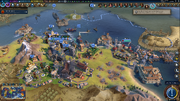
With some planning, luck and sufficient coastline, 4 Feitorias are built in Babylon.
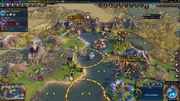
This Feitoria was built on top of  Oil.
Oil.
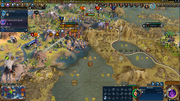
The Feitoria was removed because the  Cattle tile was submerged, making its placement illegal.
Cattle tile was submerged, making its placement illegal.
The Feitoria makes a great comeback in Civilization VI, and while it retains the unique concept from its Civilization V counterpart, the design and implementation are so much improved that the improvement is quite useful.
First and foremost, the Feitoria is now built by the Nau, a Caravel replacement, which means your Builders no longer have to brave the waves and cross the oceans. The construction of Feitorias, therefore, is reliable, fast, and efficient. Furthermore, Feitorias can now be constructed in territory of both city-states and any civilizations with which you have Open Borders (meaning that you can't build Feitorias in an opponent's territory while at war with them). Due to their unique nature, being the only improvement that has to be built in foreign territory, the Feitoria comes with a few quirks:
- The yields on the Feitoria's tile belong to the civilization that owns the tile.
- If
 Oil is revealed underneath the Feitoria, the owner of the tile will gain
Oil is revealed underneath the Feitoria, the owner of the tile will gain  Oil per turn after researching Steel (or Refining). They won't have to research Plastics as they normally would to build an Offshore Oil Rig.
Oil per turn after researching Steel (or Refining). They won't have to research Plastics as they normally would to build an Offshore Oil Rig. - Multiple Feitorias can be built in the same city, and their bonuses stack.
- Feitorias can be removed only by coastal flooding (see photos), nukes, Comet Strikes (in the Apocalypse game mode), or the host city becoming a Free City or being captured by Portugal. If a third party captures a city in which a Feitoria has been built, it will remain.
- Feitorias built next to bonus resources will not be removed if the bonus resources are harvested.
When combined with the Portuguese civilization ability, each Feitoria actually grants 6 ![]() Gold and 1.5
Gold and 1.5 ![]() Production to Portuguese
Production to Portuguese ![]() Trade Routes. Remember, because of the restriction on where Portugal can send their
Trade Routes. Remember, because of the restriction on where Portugal can send their ![]() Trade Routes, it is useless to place Feitorias where you can't send
Trade Routes, it is useless to place Feitorias where you can't send ![]() Trade Routes. However, since the Feitoria has to be built next to a bonus or luxury resource, including water resources, use it to strategically block good Harbor locations of the opponents' coastal cities. As long as those cities are directly on the coast, you can still send
Trade Routes. However, since the Feitoria has to be built next to a bonus or luxury resource, including water resources, use it to strategically block good Harbor locations of the opponents' coastal cities. As long as those cities are directly on the coast, you can still send ![]() Trade Routes to them even without them having Harbors, so this will not hurt you. Also, use Feitorias to block Kampung and Polder placements if Indonesia and the Netherlands are in the game. Although you can always build Feitorias in city-states' territory as long as you are not at war with them due to João III's ability, it is probably best to save the
Trade Routes to them even without them having Harbors, so this will not hurt you. Also, use Feitorias to block Kampung and Polder placements if Indonesia and the Netherlands are in the game. Although you can always build Feitorias in city-states' territory as long as you are not at war with them due to João III's ability, it is probably best to save the ![]() build charges for a major civilization. Since city-states' infrastructure is often underdeveloped,
build charges for a major civilization. Since city-states' infrastructure is often underdeveloped, ![]() Trade Routes sent to them without any special bonus (such as the one for being Kumasi's Suzerain) are less bountiful.
Trade Routes sent to them without any special bonus (such as the one for being Kumasi's Suzerain) are less bountiful.
There are certain games where there are not a lot of spots inside cities of major civilizations where you can put Feitorias, a fun but niche strategy in this situation would be to create an artificial Feitoria city. First settle a city with plenty of space for Feitorias (ideally this city spot should be within the trade range of many of your cities, and only close to one other empire, so that you can later nullify the Loyalty pressure from that empire by a Cultural Alliance), pre-plan where to place them, purchase the tiles necessary for the Feitorias, position enough Naus close to the designated Feitoria tiles and then hand the city over to your trading partner and form a Cultural Alliance with them. Then, move your Naus in and proceed to place as many Feitorias as possible. This, in addition to the Wisselbanken policy card and the Democracy government, allows every ![]() Trade Route to this city to yield significantly more
Trade Route to this city to yield significantly more ![]() Production and
Production and ![]() Gold.
Gold.
[]
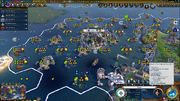
The extra  Science from the Navigation School is denoted as "12 from Terrain." Proper planning allows the Mausoleum at Halicarnassus to be built in a city on a 2-tile landmass. Auckland makes the city even more bustling.
Science from the Navigation School is denoted as "12 from Terrain." Proper planning allows the Mausoleum at Halicarnassus to be built in a city on a 2-tile landmass. Auckland makes the city even more bustling.
Simply put, the Navigation School is a great replacement for the University. It offers all the same bonuses that the University does in addition to +1 ![]() Great Admiral point, +25%
Great Admiral point, +25% ![]() Production to naval units and +1
Production to naval units and +1 ![]() Science from every two Coast or Lake tiles in the Navigation School's city, all without being more expensive to build or maintain. Naturally, as Portugal, you will want all of your cities to be coastal, and this building puts another layer of emphasis on that, since none of its bonuses can be used consistently by an inland city.
Science from every two Coast or Lake tiles in the Navigation School's city, all without being more expensive to build or maintain. Naturally, as Portugal, you will want all of your cities to be coastal, and this building puts another layer of emphasis on that, since none of its bonuses can be used consistently by an inland city.
The extra amount of ![]() Science can be really game changing if some of your cities are built on tiny landmasses surrounded by water. The total amount of
Science can be really game changing if some of your cities are built on tiny landmasses surrounded by water. The total amount of ![]() Science can triple, or even quadruple the base
Science can triple, or even quadruple the base ![]() Science granted by a University. Of course, not every city can generate a meaningful amount of bonus
Science granted by a University. Of course, not every city can generate a meaningful amount of bonus ![]() Science with this building, since it is perfectly normal to have coastal cities with very few coast tiles (especially ones on the coast of a large continent or landmass), but on average, it should have the same effects as having Isaac Newton, which is one of the most powerful and contested
Science with this building, since it is perfectly normal to have coastal cities with very few coast tiles (especially ones on the coast of a large continent or landmass), but on average, it should have the same effects as having Isaac Newton, which is one of the most powerful and contested ![]() Great Scientists.
Great Scientists.
The Navigation School is also part of the Portuguese strategy to establish Feitorias across the map. The +25% ![]() Production towards naval units allows Portugal to build large numbers of Galleys when combined with the Press Gangs military policy card, which can then be upgraded with the
Production towards naval units allows Portugal to build large numbers of Galleys when combined with the Press Gangs military policy card, which can then be upgraded with the ![]() Gold Portugal will be dripping in from their international
Gold Portugal will be dripping in from their international ![]() Trade Routes (and which they can spend less of by slotting Professional Army right before upgrading) into Naus. This gives Portugal a spectacular mid-game push around the late Medieval to early Renaissance, when their
Trade Routes (and which they can spend less of by slotting Professional Army right before upgrading) into Naus. This gives Portugal a spectacular mid-game push around the late Medieval to early Renaissance, when their ![]() Trade Routes become much stronger with policy cards such as Trade Confederation (unlocking at Mercenaries) and Wisselbanken (unlocking at Diplomatic Service). Having 2 Naus triggers the
Trade Routes become much stronger with policy cards such as Trade Confederation (unlocking at Mercenaries) and Wisselbanken (unlocking at Diplomatic Service). Having 2 Naus triggers the ![]() Inspiration for Exploration, which unlocks Merchant Republic, and allows for proactive construction of Feitorias in cities you're trading with. If you want to create a naval empire, this is the time to build the Venetian Arsenal as well, although between Press Gangs, the Navigation School, and any inherently productive tiles in a powerful coastal city, the Arsenal might be overkill and your time may be better spent just pumping out ships.
Inspiration for Exploration, which unlocks Merchant Republic, and allows for proactive construction of Feitorias in cities you're trading with. If you want to create a naval empire, this is the time to build the Venetian Arsenal as well, although between Press Gangs, the Navigation School, and any inherently productive tiles in a powerful coastal city, the Arsenal might be overkill and your time may be better spent just pumping out ships.
Victory Types[]
Much like Mali, Portugal can amass a large number of ![]() Trade Routes and fill their treasury quickly, allowing them to quickly buy infrastructure and get their new cities up and running in no time. The two most reliable routes for Portugal is undoubtedly a Diplomatic Victory, thanks to their generous
Trade Routes and fill their treasury quickly, allowing them to quickly buy infrastructure and get their new cities up and running in no time. The two most reliable routes for Portugal is undoubtedly a Diplomatic Victory, thanks to their generous ![]() Gold output and incentives to establish Alliances, or a Scientific Victory, by the virtue of the Navigation School alone. Note that these two victory conditions don't always go hand in hand, maximizing yield output in cities means putting the environment in danger, so in order to have both paths living in harmony, use your excellent
Gold output and incentives to establish Alliances, or a Scientific Victory, by the virtue of the Navigation School alone. Note that these two victory conditions don't always go hand in hand, maximizing yield output in cities means putting the environment in danger, so in order to have both paths living in harmony, use your excellent ![]() Science output to beeline for techs that give you green energy, you can still use your Power Plants while minimizing carbon discharge this way. Alternatively, if the map is so dominated by water that the Navigation School can consistently generate a lot of
Science output to beeline for techs that give you green energy, you can still use your Power Plants while minimizing carbon discharge this way. Alternatively, if the map is so dominated by water that the Navigation School can consistently generate a lot of ![]() Science, you can disregard climate change and
Science, you can disregard climate change and ![]() Diplomatic Favor penalty completely. By centralizing your
Diplomatic Favor penalty completely. By centralizing your ![]() Trade Route in your city with a Spaceport (which can be bought with Reyna's final promotion, Contractor) and running policies that enhance those routes, Portugal can finish the Scientific Victory milestones far more quickly than any other civilization in the game.
Trade Route in your city with a Spaceport (which can be bought with Reyna's final promotion, Contractor) and running policies that enhance those routes, Portugal can finish the Scientific Victory milestones far more quickly than any other civilization in the game.
A Domination Victory is doable. Portugal's approach to conquest is the same as Ethiopia, they don't have any edge in winning battles besides their outstanding income that allows them to field a massive army in an instant. Both the massive ![]() Gold and the extra
Gold and the extra ![]() Production towards naval units from the Navigation School can help with this, but since unlike Ethiopia's domination strategy, Portugal's strategy relies almost exclusively on naval conquest, it won't be smooth-sailing all the time. A Cultural Victory is also somewhat viable, thanks to their
Production towards naval units from the Navigation School can help with this, but since unlike Ethiopia's domination strategy, Portugal's strategy relies almost exclusively on naval conquest, it won't be smooth-sailing all the time. A Cultural Victory is also somewhat viable, thanks to their ![]() Trade Routes' long reach and the rapid development of infrastructure whenever they settle a new city since they are able to make numerous
Trade Routes' long reach and the rapid development of infrastructure whenever they settle a new city since they are able to make numerous ![]() Gold purchases.
Gold purchases.
Counter Strategy[]
The crux of the Portuguese empire is whether or not they can send their ![]() Trade Routes. Normally, if you bump into Portugal on a land map, there is no need to strategize against them, as their civilization ability will do a better job of shutting their entire game down than you ever can. On a water map, that same principle applies: trying to shut down their trade network as much as you can. In the mid game, with the Navigation School, Portugal can be quite decent at fending off a naval incursion since they receive a boost in
Trade Routes. Normally, if you bump into Portugal on a land map, there is no need to strategize against them, as their civilization ability will do a better job of shutting their entire game down than you ever can. On a water map, that same principle applies: trying to shut down their trade network as much as you can. In the mid game, with the Navigation School, Portugal can be quite decent at fending off a naval incursion since they receive a boost in ![]() Production towards naval units, but before that, they don't have anything to protect their
Production towards naval units, but before that, they don't have anything to protect their ![]() Trade Routes. Even when Medieval and Renaissance Era roll around, they will most likely be building only Naus, which will leave to go build Feitorias far away, leaving Portuguese territories quite open. On a map where there is a balance between land and water, like Seven Seas or Continents, you can just avoid settling directly on the Coast and/or build Harbors strictly in the third ring of your cities, which will make them invalid targets for Portuguese
Trade Routes. Even when Medieval and Renaissance Era roll around, they will most likely be building only Naus, which will leave to go build Feitorias far away, leaving Portuguese territories quite open. On a map where there is a balance between land and water, like Seven Seas or Continents, you can just avoid settling directly on the Coast and/or build Harbors strictly in the third ring of your cities, which will make them invalid targets for Portuguese ![]() Trade Routes.
Trade Routes.
Civilopedia entry[]
Portugal went from being a small medieval kingdom on the Atlantic coast of the Iberian peninsula to a massive maritime empire. At its height in the 1500s, Portugal controlled parts of South America, Africa, Asia, and Oceania. As one of the first European countries to take up colonial ventures, Portugal is responsible for the first great wave of globalization: the movement of people, ideas, and spices around the world to an extent never seen before.
Like most of Europe, the region that would one day become Portugal was rocked by regional disputes and conquests. Originally a part of Roman Lusitania, Portugal after the Roman Empire became a part of the Al-Andalus region of the Umayyad Caliphate. But don't let the word "conquest" paint too dark a picture: life in Al-Andalus during the turn of the first millennium would have been a bright spot in comparison with many parts of Western Europe, as, while Europe was going through the Dark Ages, arts and learning flourished across the peninsula via centers such as Cordoba.
Umayyad rule extended until the 1100s, when Dom Afonso Henriques led a successful rebellion. For this, Afonso I is giving the title “The Founder,” in recognition of having established the first independent Portuguese state. Afonso, along with other Christian kings in the region, continued the Reconquista - the campaign to overthrow Moorish (Muslim) rule in Iberia. Famously, Alfonso took Lisbon in 1147, aided (unintentionally) by an influx of English Crusaders taking shelter in Portugal to avoid the stormy Atlantic. Realizing that they could fight their version of the Crusades closer to home, they stayed and helped to expel the Umayyads from the region (they were permitted to loot captured cities and ransom prisoners as payment). In 1249, Afonso III captured the southern city of Faro, solidifying Portuguese dominance within the region. By the 13th century, Portugal’s borders were comparable to what they are today, and they’d made an alliance with the English that was to last through centuries.
With Portugal’s newfound independence came an age of maritime exploration. The Portuguese now controlled powerful port cities as well as the benefits of Umayyad astronomy and math, allowing them to take advantage of their coastline to travel across the known (and eventually unknown) ocean. These two traits allowed Portugal to embark on a gamble - trade with Asia by braving the dangerous waters rather than rely upon all of the middlemen who made up the Silk Road - many of whom were still smarting from the loss of the Umayyads. With this in mind, João I, with his three sons, Prince Duarte, Prince Pedro, and Prince Henry “the Navigator” kicked off the Age of Discovery - Discovery, of course, for the Portuguese; residents of Malacca, Goa, and Angola might have had another word for it. This conquest was in a sense the next step from the Reconquista - the first real overseas colony for the Portuguese was the conquest of Ceuta, in North Africa, very close to the Portuguese coast. The Portuguese continued to “explore” the seas and set up colonies starting along the coast of Africa and moving all the way to India and East Asia. By the early 1500s, there were series of Portuguese colonies nearly spanning the world, including places such as Angola, Mozambique, Somalia, Goa (in India), Malacca (in present-day Malaysia), Timor, and a trade post in Japan. The institution of these colonies and trade routes made Portugal very powerful and very wealthy within a short amount of time, as Portuguese merchants controlled the import and export of gold, spices, but also the trafficking of enslaved persons, leading to increased riches and an increased thirst for new conquests, new trade goods - and new converts to Catholicism, an emphasis that was to doom Portuguese colonies in many places; Malay sultans and Japanese daimyo didn't mind trade, but conversion threatened to break apart their political order (something of which the more canny Dutch took note).
Portugal had a friendly rivalry with their neighbor, Spain, when it came to this exploration. After Christopher Columbus “discovered” America in 1492 and solidified a Spanish claim to that territory, Portugal knew they had to find a way to one-up their neighbor. Portuguese explorers had stumbled upon the coast of Brazil, and, after a bitter dispute with Spain, the Pope had to step in to finally resolve them with the Treaty of Tordesillas, which divided up the New World’s “discoveries” : those east of the line would be Portuguese, and those west would be Spanish. Both sides found this agreeable enough (not that they’d argue with the Pope) and went about their business of conquest, but as European explorers began to fill in the map, it quickly became apparent that Spain had inherited gold-rich Mexico, Peru, and most of North America, whereas Portugal received coastal Brazil. (No one, it seemed, consulted with the indigenous peoples first).
The peace with their neighbor doesn’t last, however, and after a series of unfortunate events in Portugal led to a throne without an heir, Portugal found themselves seated with a Spanish king. Philip II of Spain claimed the throne through his mother’s line and marched on Portugal. After his decisive victories, he was crowned Philip I of Portugal (since he couldn’t be Philip II there, with no prior Philip I). Portugal wouldn’t be independent again until 1640 after the Portuguese Restoration War, and even then, they had to wait another 28 years for Spain to recognize that independence.
Fortune appeared to follow after that when gold was discovered in Brazil. The new flow of wealth helped to enrich Portugal’s economy and gave them a financial cushion, something sorely needed when a magnitude nine earthquake hit Lisbon in 1755. Sebastião José de Carvalho e Melo, or the Marquis of Pombal for short, survived the destruction and without a pause, went about rebuilding the city. His swift action had the city rebuilt in a year, and in a stroke of brilliance, he had the buildings designed to withstand earthquakes.
Napoleon invaded Portugal as a part of his conquest of Europe in the 1800s, and when he seized Lisbon, the Portuguese capital moved to Brazil, in Rio de Janeiro. Portugal pushed back Napoleon with the help of their English allies – solidifying a bond that had been present since the beginning. But this move was the end of Portugal's Brazilian claim: at the end of the war, Lisbon became the capital once again after Brazil declared its independence from Portugal.
Portugal today remains a strongly Catholic nation, and is a core member of the European Union. It remains famous for its food and drink (including green wine!), melancholic fado music, and cosmopolitan outlook. Portugal and Britain keep close ties, although in peak tourist season the Portuguese might sometimes think twice…
Cities[]
Citizens[]
| Males | Females | Modern males | Modern females |
|---|---|---|---|
| Airas | Toda | Diogo | Marta |
| Ansur | Eyria | Goncalo | Ida |
| Bellchior | Margaida | Marco | Joanna |
| Estevoo | Maior | Luis | Aisa |
| Joam | Lyonor | Duarte | Laira |
| Loys | Katalina | Leandro | Ines |
| Lopo | Guymar | Francesco | Mariana |
| Pero | Ilduara | Rodrigo | Rita |
| Mendo | Ilena | Octavio | Sofia |
| Xil | Giomar | Bruno | Carina |
Trivia[]
- The Portuguese civilization ability is named after the organization responsible for regulating Portuguese international trade and overseeing their possessions in Africa and Asia.
- The Portuguese civilization's symbol is the Portuguese shield, which appears on both its coat of arms and flag.
- Before the Portuguese civilization was released, the Portuguese city of Lisbon was a city-state. After Portugal's release, Lisbon became one of the Portuguese cities, and it was replaced by Mogadishu.
- The introduction of the Portuguese in Civilization VI marks the fourth time they have been featured in the Civilization franchise, every time led by a different leader: Prince Henry the Navigator in Civilization III, João II in Civilization IV, Maria I in Civilization V, and João III in Civilization VI.
Gallery[]
Videos[]
Related achievements[]

|

|
Ultramar Português
As Portugal, have a Trading Post in cities belonging to Brazil, India, and Japan.
|
References[]
See also[]
- Portuguese in other games
External links[]
| Civilization VI Civilizations [edit] |
|---|
| American • Arabian • Australian1 • Aztec • Babylonian1 • Brazilian • Byzantine1 • Canadian |
| 1 Requires DLC
|


